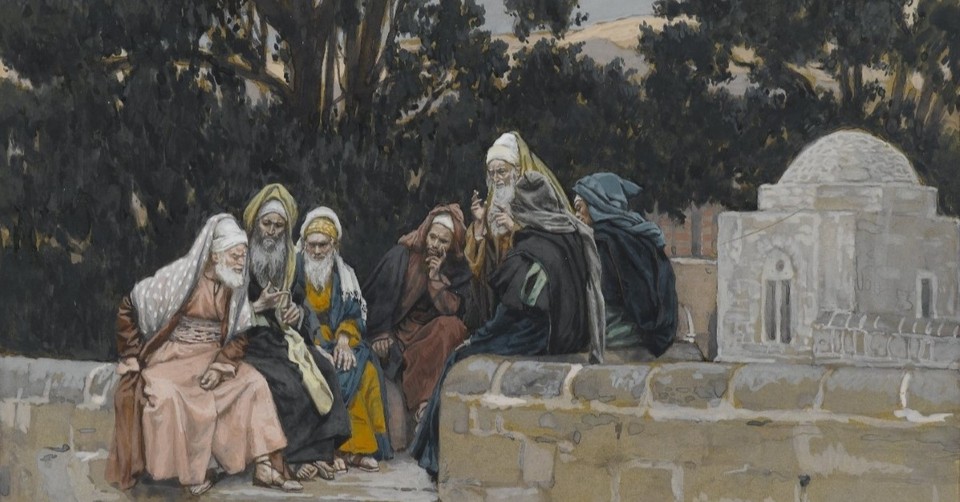Why Did Jesus Clash with the Pharisees and Sadducees?

While Jesus taught and ministered, he clashed with other Jewish religious groups. The two main Jewish doctrinal sects, the Pharisees and the Sadducees, continually challenged Christ and his followers.
These two sect names seem foreign to us today, but we might relate to them if we used denominational terms (“Baptist,” “Pentecost,” “Episcopalian,” etc.). Just as our modern faith has different denominations with different emphases, Judaism also has denominations.
We should familiarize ourselves with the Pharisees and Sadducees to better understand Jesus’ context and the people who challenged him.
Who Were the Pharisees and the Sadducees?
The Pharisees emerged during the Second Temple period, around the second century BC, as a group dedicated to strict adherence to the Torah (the Old Testament’s first five books) and the oral traditions developed to support the Mosaic system. They believed in the importance of both the written and oral laws, which they argued had been passed down from Moses. The oral law included Torah interpretations and applications to everyday life, making it more adaptable to contemporary circumstances.
In context, the Jews believed the Babylonian exile stemmed from their disobedience to the Law. The Persians allowed them to return, but the Jews then fell under Greek and later Roman rule. Pharisaical legalism attempted to keep the Jews from another exile. They also believed that obedience to God could lead to their freedom and, eventually, to self-government again.
The Pharisees believed in the resurrection of the dead, angels and spirits, and divine providence. They emphasized personal piety, ritual purity, prayer, and charity.
Pharisees were generally more popular with the common people due to their teachings on the importance of living a righteous life according to God’s commandments, which translated well into the widespread synagogue system throughout the Roman Empire.
The Sadducees were a more aristocratic group. By Jesus’ time, they were closely associated with the temple worship in Jerusalem and held significant power within the Sanhedrin, the Jewish ruling council.
Sadducees accepted only the written Torah and rejected the oral traditions upheld by the Pharisees. They did not believe in Jewish supernatural elements—the resurrection, angels, spirits, or an afterlife, even if the Old Testament could support it. Their focus was on maintaining the sacrificial system and temple rituals.
The Sadducees, being from the wealthy class, had a closer relationship with the Roman authorities who occupied Judea. They sought to maintain their power and influence by cooperating with the Romans and ensuring their stable positions. Many embraced Hellenization, becoming more like Greeks and Romans. They could hold administrative or representative positions in the government. This often made them more resistant to changes that could disrupt the status quo.
Although willing to cooperate with the Romans, the Pharisees were more independent and often critical of the ruling powers. They were more concerned with Jewish everyday life and aimed to make the Law applicable to daily life, which sometimes put them at odds with the Sadducees, especially on religious interpretation and practice.
Did Any Pharisees or Sadducees Spend Time with Jesus?
Although interactions with the Pharisees and Sadducees were often contentious, there were notable instances where individual Pharisees engaged with Jesus more positively, either from curiosity, respect, or genuine interest in his teachings.
One notable Pharisee who spent time with Jesus is Nicodemus. As described in John, Nicodemus was a member of the Jewish ruling council, the Sanhedrin. He approached Jesus at night, possibly to avoid religious scrutiny, seeking to understand Jesus’ teachings. In John 3:1-21, Nicodemus acknowledges Jesus as a teacher sent from God due to the miracles he performed, which would likely place Nicodemus among the Pharisees.
Jesus uses this opportunity to teach Nicodemus about spiritual rebirth, famously stating, “Very truly I tell you, no one can see the kingdom of God unless they are born again” (John 3:3). Nicodemus’s interaction with Jesus indicates respect and openness to his message, contrasting with the generally hostile attitude of many Pharisees.
Nicodemus appears again in John 7:50-51, where he defends Jesus before the Sanhedrin, arguing that the law requires a fair hearing before judging someone. After Jesus’ crucifixion, Nicodemus assists Joseph of Arimathea in preparing Jesus’ body for burial (John 19:38-42).
Joseph of Arimathea, mentioned in all four Gospels, was a wealthy member of the Sanhedrin and a secret disciple of Jesus. Although not explicitly identified as a Pharisee, his membership in the Sanhedrin and his actions suggest he might have had affiliations with them. After Jesus’ crucifixion, Joseph courageously asked Pilate for Jesus’ body and provided his own tomb for Jesus’ burial.
Interactions between Jesus and the Sadducees were less frequent but typically marked by theological and political disputes. The Sadducees challenged Jesus on matters of doctrine, particularly the resurrection, which they denied. Jesus refuted their misunderstanding of the scriptures and God’s power, thereby silencing them.
In Luke 7:36-50, a Pharisee named Simon invited Jesus to his home for dinner. During the meal, a sinful woman anointed Jesus’ feet with her tears and expensive perfume, wiping them with her hair. Simon silently questioned Jesus’ prophetic ability to allow such a woman to touch him. Jesus, perceiving Simon’s thoughts, used the opportunity to teach about forgiveness and love, illustrating how those who are forgiven much, love much. While the Pharisees and Sadducees often questioned Jesus, they also provided contexts for his teaching moments.
Did the Pharisees and Sadducees Both Clash with Jesus?
The Pharisees were often legalistic, emphasizing meticulous observance of the law and traditions. Jesus, however, taught the spirit of the law, focusing on the underlying principles of love, mercy, and justice. In Matthew 23:23-24, Jesus rebuked the Pharisees for neglecting “the weightier matters of the law: justice, mercy, and faithfulness” while being overly concerned with minor ritual details.
Jesus condemned the Pharisees for their hypocrisy, criticizing them for performing religious acts to gain public admiration rather than genuine devotion. In Matthew 23:27, he compares them to “whitewashed tombs” that appear beautiful outwardly but are filled with dead bones and impurities inside. Jesus targeted their emphasis on external observance over internal transformation.
The Pharisees rigidly observed the Sabbath, condemning any form of work, including acts of healing. However, Jesus performed miracles on the Sabbath, teaching that “the Sabbath was made for man, not man for the Sabbath” (Mark 2:27). He revealed the Sabbath's purpose as a day of rest and healing, which clashed with the Pharisees’ legalistic attitude that would deny helping the poor and sick.
The Sadducees denied any afterlife, which was central to Jesus’ teachings. He claimed to be from heaven and regularly spoke about the Kingdom reward. The Sadducees tried to trap Jesus with a question about marriage, trying to point out how they viewed the resurrection’s ridiculous nature. If a person had a series of marriages, who would their wife be in heaven? Jesus refuted their understanding, first saying how marriage doesn’t exist in heaven. Second, he stated, “He is not the God of the dead but of the living” (Matthew 22:32), affirming the resurrection and eternal life.
The Sadducees’ authority was deeply tied to the temple. Jesus’ actions in cleansing the temple, driving out the money changers, and criticizing the commercialization of worship (Matthew 21:12-13) directly challenged their power and practices.
Why Did the Pharisees and Sadducees Both Want Jesus Dead?
Despite their differences, both the Pharisees and Sadducees found common ground in their desire to eliminate Jesus.
For the Sadducees, Jesus’ growing popularity and his actions in the temple directly threatened their authority and the delicate balance they maintained with the Romans. In addition, the Sadducees denied the resurrection and the afterlife, so Jesus’ continual teaching on these topics undermined their theological positions and authority. Christ’s doctrines lead them to view him as a dangerous heretic.
The Pharisees, while more populist than the Sadducees, also saw Jesus as a threat to their legal interpretation and social influence. In passages like Matthew 23, Jesus denounced the Pharisees as hypocrites who focused on outward observance rather than inner righteousness. His critiques threatened their credibility and authority among the people. Jesus’ teachings and miracles attracted large crowds, undermining the Pharisees’ influence in synagogues and among the Jewish population. His association with sinners, tax collectors, and those considered unclean contradicted the Pharisaic emphasis on ritual purity and separation from impurity (Matthew 9:10-11).
The Sadducees, the more powerful members of the Jewish religious council, feared Jesus’ potential to incite unrest and disrupt their cooperation with the Romans. His actions in the temple and his messianic claims threatened their political power and the economic benefits derived from temple activities.
The Sadducees and other Jewish leaders reacted strongly when Jesus entered Jerusalem before Passover. Upon Christ’s arrival, the Jewish crowd greeted him with shouts of “Hosanna” and hailed him as “King of the Jews” and the “Son of David.” (Matthew 21) Jewish crowds gathered, laying down palm branches and cloaks on the road to honor him. They recognized him as the promised Messiah, chanting praises and worshipping him as a king.
In John 11:47-53, the high priests and Pharisees convened a council to discuss Jesus, expressing their fear that the Romans might destroy their temple and nation if he continued. Caiaphas, the high priest, argued that it was better for one man to die than for the whole nation to perish, encapsulating the pragmatic and self-preserving rationale behind their conspiracy. The religious leaders, the Sanhedrin and primarily Sadducees, appealed to Rome’s authority to have Jesus crucified. The Jewish leaders pointed to Jesus’ kingly claims as a threat to Rome. In reality, Jesus, as king, threatened Herod more than Rome, and Pilate responded, “Shall I kill your king?” The Jewish leaders declared, “We have no king but Caesar!” (John 19:15)
Ultimately, Jesus proved himself king over all (and the resurrection) when he rose from the dead three days later. For Christians today, we should remember these groups as a serious warning. Let us not take our denominational or political positions so seriously that we miss or end up denying Christ’s eternal Lordship. Rather than judge these Jewish schools, we should search our hearts and repent for ways we are like them.
Peace.
Photo Credit: Public domain (James Tissot painting via Wikimedia Commons)

This article is part of our People from the Bible Series featuring the most well-known historical names and figures from Scripture. We have compiled these articles to help you study those whom God chose to set before us as examples in His Word. May their lives and walks with God strengthen your faith and encourage your soul.
4 Things You May Not Know About Abraham in the Bible
20 Facts You May Not Know About Moses from the Bible
Who Was Mary Magdalene in the Bible?
Who Were the 12 Disciples of Jesus?
Who Was Isaiah & Why Was He Important?
Originally published August 09, 2024.







